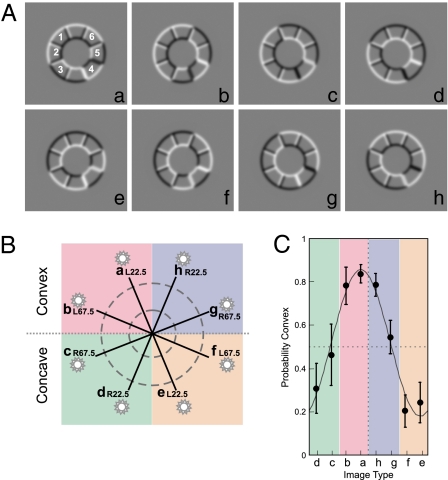Fig. 1.
Stimuli and behavioral performance. (A) Examples of stimuli. Each image is interpreted as a convex or concave ring lit from one of four light directions. All eight image types (a–h) are ambiguous. For instance, image ”a” can be interpreted as a convex ring with a light source located above-left or as a concave ring with a light below-right. One of the elements of the ring, randomly chosen from one of six possible locations (numbered 1 through 6 in image “a”), has a shape opposite to that of the ring. In the behavioral task, observers were asked to report the perceived shape of this odd element. (B) Four classes of stimuli. To simplify the description of the stimuli in this article, we adopt the convention that the depicted shape of a stimulus is that consistent with a light coming from above. Following this convention, images “a,” “b,” “g,” and “h” will be referred to as convex rings and images “c,” “d,” “e,” and “f” as concave rings. The four main classes of stimuli are assigned different color codes: pink for convex shape lit from the left, green for concave-right, orange for concave-left, and blue for convex-right. (C) Behavioral performance in discriminating the shape of the odd element. The plot shows the probability that observers reported a convex ring (thus a concave odd element) as a function of light direction. In this plot, all six possible locations of the odd elements were pooled. The most ambiguous images were “c” and “g.” The solid line is the best fit of a scaled cosine function to illustrate the bias to above-left for the assumed light direction. Error bars are SEs across observers (n = 7).

